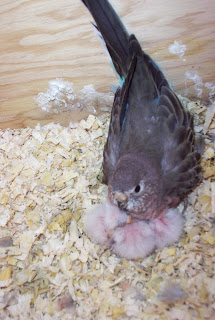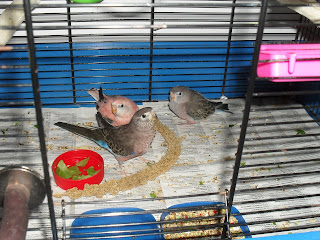Rosie and Fuchsia aren't related, but they look remarkably alike. Actually, Fuchsia is Rosie's sister-in-law. Her mate is Rosie's brother.
 |
| Some look-alike Rosy Bourkes. Others waiting to come out and fly around, including Splendids in top cage. |
Fuchsia is a feisty little bird who chases other hens...the only Bourke I've had do this. Rosie is sweet to everyone. Both are very tame, but Fuchsia seems jealous of others and goes after them. Hence, I usually don't let Fuchsia and her mate, Flame, out of their cage when the others are.
It so happened, however, that one day last week I did. Rosie used to have a split blue band on her leg that made it easy to differentiate between the two birds. Now that band was gone. She'd picked at it over the years and eventually was able to remove it. She still has her solid silver band, #4. Fuchsia's is #18.
| My dog, Chinook, who is safe around birds, and visiting Sammy, who isn't. |
For a week, I wasn't able to let the birds out of their cages because of a visiting little dog (Maltese/Poodle mix) whose "mom" was in the hospital. For their safety, the birds stayed caged. (His owner is home now and recovering nicely).
It seemed odd to me that Fuchsia was suddenly so friendly. When the puppy went home and I let the birds out again, "Rosie" was acting like Fuchsia by chasing the other birds. "Fuchsia," still in her cage, made me stop and think. I adjusted the band on "Rosie's" foot and it read #18! Fuchsia had been living with Pretty Boy for several days and Rosie was in with her brother.
How I made that mistake, I'm not sure. Today, they are happily re-ensconced with their own spouses. Smile. Good thing it's not breeding season!
 |
| This pair is easier to recognize, smile. Sugar and Spice. She is a Rosy Bourke hen, he is a Normal male Bourke. |
Peace and Blessings.












